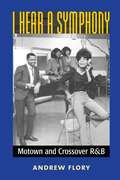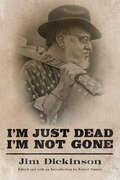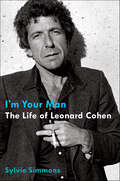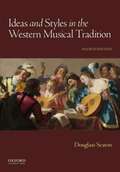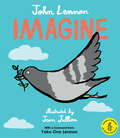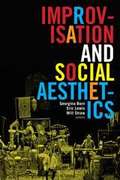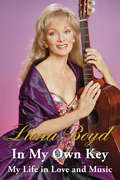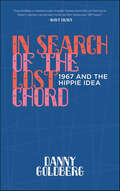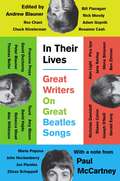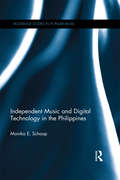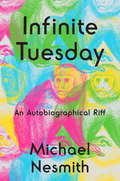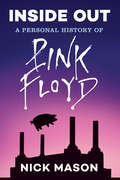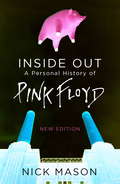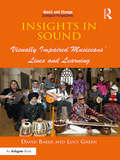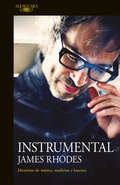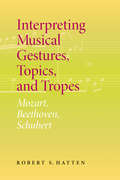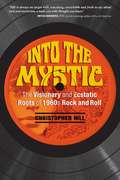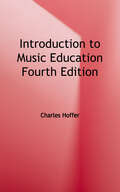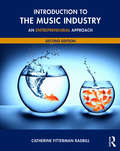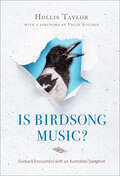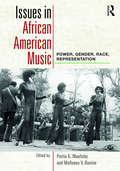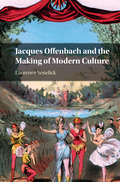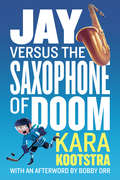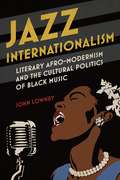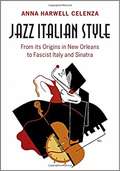- Table View
- List View
I Hear a Symphony: Motown and Crossover R&B
by Andrew FloryI Hear a Symphony opens new territory in the study of Motown’s legacy, arguing that the music of Motown was indelibly shaped by the ideals of Detroit’s postwar black middle class; that Motown’s creative personnel participated in an African-American tradition of dialogism in rhythm and blues while developing the famous “Motown Sound.” Throughout the book, Flory focuses on the central importance of “crossover” to the Motown story; first as a key concept in the company’s efforts to reach across American commercial markets, then as a means to extend influence internationally, and finally as a way to expand the brand beyond strictly musical products. Flory’s work reveals the richness of the Motown sound, and equally rich and complex cultural influence Motown still exerts.
I'm Just Dead, I'm Not Gone (American Made Music Series)
by Jim DickinsonI'm Just Dead, I'm Not Gone chronicles Jim Dickinson's extraordinary life in the Memphis music scene of the fifties and sixties and how he went on to play with and produce a rich array of artists, including Aretha Franklin, the Rolling Stones, Ry Cooder, Duane Allman, Arlo Guthrie, and Albert King. With verve and wit, Dickinson (1941–2009) describes his trip to Blind Lemon's grave on the Texas flatlands as a college student and how that encounter inspired his return to Memphis. Back home, he looked up Gus Cannon and Furry Lewis, began staging plays, cofounded what would become the annual Memphis Blues Festival, and started recording. The blues, Elvis, and early rock 'n' roll compelled Dickinson to reject racial barriers and spurred his contributions to the Memphis music and experimental art scene. He explains how the family yardman, WDIA, Dewey Phillips, Furry Lewis, Will Shade, and Howlin' Wolf shaped him and recounts how he went on to learn his craft at Sun, Ardent, American, Muscle Shoals, and Criteria studios from master producers Sam Phillips, John Fry, Chips Moman, and Jerry Wexler. Dickinson is a member of the Mississippi Music Hall of Fame and an inaugural inductee of the Memphis Music Hall of Fame. He has received the Lifetime Achievement Award for Engineering and Production from the Americana Music Association, a Brass Note on the Beale Street Walk of Fame in Memphis, and a Heritage Marker on the Mississippi Blues Trail. This memoir recounts a love affair with Memphis, the blues, and rock 'n' roll through Dickinson's captivating blend of intelligence, humor, and candor.
I'm Your Man: The Life of Leonard Cohen
by Sylvie Simmons“The major, soul-searching biography that Leonard Cohen deserves [from] a seasoned rock journalist" (Janet Maslin, New York Times).Leonard Cohen is one of the most important and influential musical artists of the past fifty years—and one of the most elusive. In I’m Your Man, journalist Sylvie Simmons, one of the foremost chroniclers of the world of rock ’n’ roll and popular music, explores the legendary singer/songwriter’s extraordinary life and creative genius.I’m Your Man is an intimate and insightful appreciation of the man responsible for “Suzanne,” “Bird on a Wire,” “Hallelujah,” and so many other unforgettable, oft-covered ballads and songs. Based on Simmons’s unparalleled access to Cohen—and written with her hallmark blend of intelligence, integrity, and style—I’m Your Man is the definitive biography of a major musical artist widely considered in a league with the great Bob Dylan.Readers of Life by Rolling Stone Keith Richards and Patti Smith’s phenomenal Just Kids will be riveted by this fascinating portrait of a singular musical icon.
Ideas and Styles in the Western Musical Tradition
by Douglass SeatonIdeas and Styles in the Western Musical Tradition, Fourth Edition, explores the conceptual frameworks that have shaped musical development from antiquity to the present. In a lively narrative that prompts readers to think both critically and creatively, Douglass Seaton uses historical documents from thinkers, artists, and musicians to add rich detail to the compelling story of Western music. This brief and accessible narrative of music history features numerous works of art, literature, and music that immerse students in the historical and intellectual contexts of musical styles.
Imagine: Level 5 - Intermediate Showcase Solos Pop Sheet (Original Sheet Music Edition Ser.)
by John Lennon Jean JullienImagine all the people living life in peace. You may say I'm a dreamer, but I'm not the only one. I hope some day you'll join us, and the world will be as one. Join one little pigeon as she sets out on a journey to spread a message of tolerance around the world. Featuring the lyrics of John Lennon’s iconic song and illustrations by the award-winning artist Jean Jullien, this poignant and timely picture book dares to imagine a world at peace. Imagine will be published in partnership with human rights organization Amnesty International.
Improvisation and Social Aesthetics
by Will Straw Georgina Born Eric LewisAddressing a wide range of improvised art and music forms—from jazz and cinema to dance and literature—this volume's contributors locate improvisation as a key site of mediation between the social and the aesthetic. As a catalyst for social experiment and political practice, improvisation aids in the creation, contestation, and codification of social realities and identities. Among other topics, the contributors discuss the social aesthetics of the Association for the Advancement of Creative Musicians, the Feminist Improvising Group, and contemporary Malian music, as well as the virtual sociality of interactive computer music, the significance of "uncreative" improvisation, responses to French New Wave cinema, and the work of figures ranging from bell hooks and Billy Strayhorn to Kenneth Goldsmith. Across its diverse chapters, Improvisation and Social Aesthetics argues that ensemble improvisation is not inherently egalitarian or emancipatory, but offers a potential site for the cultivation of new forms of social relations. It sets out a new conceptualization of the aesthetic as immanently social and political, proposing a new paradigm of improvisation studies that will have reverberations throughout the humanities.Contributors. Lisa Barg, Georgina Born, David Brackett, Nicholas Cook, Marion Froger, Susan Kozel, Eric Lewis, George E. Lewis, Ingrid Monson, Tracey Nicholls, Winfried Siemerling, Will Straw, Zoë Svendsen, Darren Wershler
In My Own Key: My Life in Love and Music
by Liona BoydExotic venues, sold-out concerts, and the companionship of the world’s most powerful people have given Liona Boyd a lifestyle that, like her music, is one in a million. Exotic venues, sold-out concerts, and the companionship of the world’s most powerful people have given Liona Boyd a lifestyle that, like her music, is one in a million. The internationally acclaimed classical guitarist has crossed numerous boundaries, both musically and romantically. In this colourful memoir covering her life up to 1998, she serves up a rich and fascinating mix: childhood with her progressive parents in England, Canada, and Mexico, exacting music studies in Toronto, down-and-out years in London and Paris, her eight-year romance with Canadian prime minister Pierre Elliott Trudeau, drug experimentation in a Mexican artists’ colony, and whirlwind trips around the globe to eminent concert stages. It all makes for a rousing, feisty, passionate tale, as compelling and entrancing as the music of her Ramírez guitar.
In Search of the Lost Chord: 1967 and the Hippie Idea
by Danny GoldbergThis paperback edition of Goldberg’s highly acclaimed homage to 1967 includes a new afterword and twenty beautiful and evocative photographs.“Antiwar radicals, recoiling from soullessness, challenged the church of technocratic rationality. Taking this challenge seriously, recovering the mood of an extended moment, requires beginning earlier and ending later than 1968. Cultural upheaval cannot be confined by the calendar. At least one contribution to the literature, the music industry executive Danny Goldberg’s In Search of the Lost Chord, treats 1967 as the defining moment when ‘the hippie idea’ still held transformational promise, and countercultural protest had not yet succumbed to police violence, undercover provocateurs, or media caricature—while 1968, in contrast, was a dark time of assassinations, riots, and the resurgence of the right.” —New York Review of Books“[Goldberg’s] newest book, In Search of the Lost Chord: 1967 and the Hippie Idea, explores and fuses together the musical, political, and spiritual revolutions of the time into a narrative about a moment when ‘there was an instant sense of tribal intimacy one could have even with a stranger.'” —Rolling StoneIn Search of the Lost Chord is a subjective history of 1967, the year Danny Goldberg graduated from high school. It is also a refreshing and new analysis of the era; by looking at not only the political causes, but also the spiritual, musical, and psychedelic movements, Goldberg provides a unique perspective on how and why the legacy of 1967 lives on today. 1967 was the year of the release of the Beatles’ Sgt. Pepper’s Lonely Hearts Club Band, and of debut albums from the Doors, the Grateful Dead, Jimi Hendrix, and Janis Joplin, among many others. 1967 was also the year of the Summer of Love; the year that millions of now-illegal LSD tabs flooded America; Muhammad Ali was convicted of avoiding the draft; Martin Luther King Jr. publicly opposed the war in Vietnam; Stokely Carmichael championed Black Power; Israel won the Six-Day War; and Che Guevara was murdered. It was the year that hundreds of thousands of protesters vainly attempted to levitate the Pentagon. It was the year the word “hippie” peaked and died, and the Yippies were born. Exhaustively researched and informed by interviews and conversations with Allen Ginsberg, Timothy Leary, Ram Dass, Tom Hayden, Cora Weiss, Grace Slick, and others, In Search of the Lost Chord is a mosaic of seminal moments in the psychedelic, spiritual, rock-and-roll, and political protest cultures of 1967. This paperback edition includes a brand-new afterword by the author, along with twenty photographs by Peter Simon.
In Their Lives: Great Writers on Great Beatles Songs
by Andrew BlaunerFor readers who loved Tune In and Nick Hornby’s Songbook, an anthology of essays from a chorus of twenty-nine luminaries singing the praises of their favorite Beatles songs. The Beatles’ influence—on their contemporaries, on our cultural consciousness, and on the music industry ever after—is difficult to overstate. We all have a favorite song from the band that made us want to fall in love, tune in, and follow our dreams. Arranged chronologically by the date of the song’s release, these essays highlight both the Beatles’ evolution as well as the span of generations their music affected. From Beatlemaniacs who grew up listening to the iconic albums on vinyl to new fans who download the songs on iTunes, each contributor explores a poignant intersection between Beatles history and personal history. With contributions from twenty-nine authors and musicians—Roz Chast on “She Loves You,” Jane Smiley on “I Want to Hold Your Hand,” Rosanne Cash on “No Reply,” Gerald Early on “I’m a Loser,” Rick Moody on “The End,” Maria Popova on “Yellow Submarine,” David Duchovny on “Dear Prudence,” Chuck Klosterman on “Helter Skelter,” David Hadju on “You Know My Name (Look Up the Number),” and more—the breadth of the band’s impact is clear. From musings on young love and family strife to explorations of racial boundaries and identity, these essays pay tribute to a band that ran the gamut of human experience in a way no musical group has done before or since.Timed for the fiftieth anniversary of the release of Sgt. Pepper’s Lonely Hearts Club Band, this anthology captures the full spectrum of reasons fans still love the Fab Four after all these years.
Independent Music and Digital Technology in the Philippines (Routledge Studies in Popular Music)
by Monika E. SchoopSince the turn of the century, the impact of digital technologies on the promotion, production and distribution of music in the Philippines has both enabled and necessitated an increase in independent musical practices. In the first in-depth investigation into the independent music scene in the Philippines, Monika E. Schoop exposes and portrays the as yet unexplored restructurings of the Philippine music industries, showing that digital technologies have played an ambivalent role in these developments. While they have given rise to new levels of piracy, they have also offered unprecedented opportunities for artists. The near collapse of the transnational recording industry in the Philippines stands in stark contrast to a thriving independent music scene in the county's national capital region, Metro Manila, which cuts across musical genres and whose members successfully adjust to a rapidly evolving industry scenario. Independent practices have been facilitated by increased access to broadband Internet, the popularity of social media platforms and home recording technology. At the same time, changing music industry structures often leave artists with no other option but to operate independently. Based on extensive fieldwork online and offline, the book explores the diverse and innovative music production, distribution, promotion and financing strategies that have become constitutive of the independent music scene in twenty-first-century Manila.
Infinite Tuesday: An Autobiographical Riff
by Michael NesmithMichael Nesmith’s eclectic, electric life spans his star-making role on The Monkees, his invention of the music video, and his critical contributions to movies, comedy, and the world of virtual reality. Above all, his is a seeker’s story, a pilgrimage in search of a set of principles to live by. That search took Nesmith from a childhood in Dallas, where his single mother Bette invented Liquid Paper, to the set of The Monkees in Los Angeles; to the heart of swinging London with John Lennon and Jimi Hendrix; and to an unexpected oasis of brilliance in the Santa Fe desert, where his friendships with Douglas Adams and Los Alamos scientists would point him toward the power of the infinite and the endless possibilities of human connection. This funny, thoughtful, self-aware book is a window onto an unexpected life, inflected at every turn by the surprising candor and absurdist humor of an American original. Opening Infinite Tuesday is like stepping into the world of Michael Nesmith, where something curious is always unfolding, and where riffs on everything from bands to dogs to the nature of reality make for an endlessly engaging journey.
Inside Out (Reading Edition): A Personal History of Pink Floyd (Reading Edition)
by Nick MasonThe definitive history of Pink Floyd by founding member Nick Mason, this reading edition brings up-to-date the band's incredible story as told uniquely from the inside out. Including the complete text of the original in an easy-toread format, a new chapter covering the passing of Rick Wright and the release of the group's final album, and 80 pages of images from Mason's archives plus new photos, Inside Out is a masterly rock memoir and an eye opener for both veteran fans and those just discovering the group.
Inside Out: A Personal History of Pink Floyd
by Nick MasonUPDATED FOR 2017 WITH A NEW CHAPTERThe definitive history of Pink Floyd, one of the world's great bands, by founder member Nick Mason.Pink Floyd is one of the most creative, successful and enduring bands of all time. As the only member to have been part of the band throughout the 50 years of its existence, and the first to write a personal take on their history, Nick Mason gives unique insights into Pink Floyd's highs and lows: from their emergence in the late 1960s underground, to the huge worldwide success of The Dark Side of the Moon and the rifts and pressures that developed within the group.In a new chapter Nick Mason looks back at the years following the band's final performance at Live 8 in July 2005 and reflects on the huge changes that have occurred since: the irreplaceable losses, the new releases and the impact on the Floyd's continued success of both digital technology and social media. Intelligent, original and self-deprecating, Inside Out is the first-hand story of a band that has become a legend, as celebrated by the Victoria & Albert Museum's landmark Pink Floyd exhibition in 2017.
Insights in Sound: Visually Impaired Musicians' Lives and Learning (Music and Change: Ecological Perspectives)
by David Baker Lucy GreenMusic has long been a way in which visually impaired people could gain financial independence, excel at a highly-valued skill, or simply enjoy musical participation. Existing literature on visual impairment and music includes perspectives from the social history of music, ethnomusicology, child development and areas of music psychology, music therapy, special educational needs, and music education, as well as more popular biographical texts on famous musicians. But there has been relatively little sociological research bringing together the views and experiences of visually impaired musicians themselves across the life course. Insights in Sound: Visually Impaired Musicians’ Lives and Learning aims to increase knowledge and understanding both within and beyond this multifaceted group. Through an international survey combined with life-history interviews, a vivid picture is drawn of how visually impaired musicians approach and conceive their musical activities, with detailed illustrations of the particular opportunities and challenges faced by a variety of individuals. Baker and Green look beyond affiliation with particular musical styles, genres, instruments or practices. All 'levels' are included: from adult beginners to those who have returned to music-making after a gap; and from 'regular' amateur and professional musicians, to some who are extraordinarily 'elite' or 'successful'. Themes surrounding education, training, and informal learning; notation and ear playing; digital technologies; and issues around disability, identity, opportunity, marginality, discrimination, despair, fulfilment, and joy surfaced, as the authors set out to discover, analyse, and share insights into the worlds of these musicians.
Instrumental: A Memoir Of Madness, Medication, And Music
by James RhodesAs memórias de um aclamado pianista que se salvou do inferno da depressão e do abuso graças à música. Uma inspiradora história de redenção. Mais de 100 mil leitores se deixaram tocar por este testemunho de superação. «Abusaram de mim aos seis anos. Internaram-me num hospital psiquiátrico. Fui viciado em drogas e álcool. Tentei suicidar-me cinco vezes. Separaram-me do meu filho. Mas não vou falar disso. Vou falar de música. Porque Bach salvou-me a vida. E eu amo a vida.» James confiava naquele homem simpático. Porque não haveria de confiar? Era seu professor na escola primária. A primeira oferta foi uma caixa de fósforos, um maravilhoso objecto de desejo para um menino de seis anos. Seguiram-se outros pequenos presentes, acompanhados de sorrisos, palavras de incentivo, gestos atenciosos. Depois começaram os abusos sexuais, que duraram vários anos, sem que ninguém na escola e na família se apercebesse. Quando terminaram, James afundou-se progressivamente num abismo de relações obsessivas, hospitais psiquiátricos e vícios destrutivos, uma espiral que o afastou do piano, para o qual revelara talento precoce. Mas foi um adágio de Bach, escutado durante um internamento, que o salvou de anos no fundo do poço. Ao descobrir que também os génios por trás das mais sublimes composições eram homens com existências dramáticas, James encontrou nos pequenos milagres da música o reduto para sobreviver aos seus demónios pessoais. Um encontro inesperado com um desconhecido deu-lhe o impulso de que James precisava para reencontrar o seu caminho na música. Hoje é um pianista aclamado em todo o mundo. Instrumental é um testemunho apaixonado e apaixonante, negro e luminoso, sobre o poder terapêutico da música e a sua capacidade de transformar as nossas vidas, mas também, e sobretudo, sobre a nossa capacidade de reinvenção. Os elogios da crítica: «Rhodes prova que a arte e a beleza podem ajudar; prova que a vida pode ser conquistada dia a dia.»El País «Estávamos a precisar deste livro.»Huffington Post UK «O que distingue este livro é a forma como ele confronta os aspectos indizíveis do abuso sexual das crianças e das doenças mentais... Muitos destes pensamentos são tabu e é preciso clareza, coragem e inteligência para os expressar de forma tão directa e honesta como Rhodes faz.»Independent «Bem escrito, coloquial, tão excitante quanto devastador. Como documento dos efeitos do abuso de crianças é, provavelmente, insuperável.»Sunday Times «Nunca li um testemunho tão sábio sobre o que é ser-se vítima... É visceral e palpável... Das páginas mais impactantes que li nos últimos tempos.»Scotland on Sunday «Uma obra impressionante. Combina uma precisão vívida e obsessiva com uma energia torrencial.»Guardian «Uma leitura dura, avassaladora.»The Times «Poderoso.»New Statesman «Uma vida que tinha de ficar registada.»Spectator
Interpreting Musical Gestures, Topics, and Tropes: Mozart, Beethoven, Schubert
by Robert S. HattenRobert Hatten’s new book is a worthy successor to his Musical Meaning in Beethoven, which established him as a front-rank scholar... in questions of musical meaning.... [B]oth how he approaches musical works and what he says about them are timely and to the point. Musical scholars in both musicology and theory will find much of value here, and will find their notions of musical meaning challenged and expanded." —Patrick McCrelessThis book continues to develop the semiotic theory of musical meaning presented in Robert S. Hatten’s first book, Musical Meaning in Beethoven (IUP, 1994). In addition to expanding theories of markedness, topics, and tropes, Hatten offers a fresh contribution to the understanding of musical gestures, as grounded in biological, psychological, cultural, and music-stylistic competencies. By focusing on gestures, topics, tropes, and their interaction in the music of Mozart, Beethoven, and Schubert, Hatten demonstrates the power and elegance of synthetic structures and emergent meanings within a changing Viennese Classical style.Musical Meaning and Interpretation—Robert S. Hatten, editor
Into the Mystic: The Visionary and Ecstatic Roots of 1960s Rock and Roll
by Christopher HillExplores the visionary, mystical, and ecstatic traditions that influenced the music of the 1960s • Examines the visionary, spiritual, and mystical influences on the Grateful Dead, the Beatles, the Rolling Stones, Bob Dylan, Van Morrison, the Incredible String Band, the Left Banke, Lou Reed and the Velvet Underground, and others • Shows how the British Invasion acted as the “detonator” to explode visionary music into the mainstream • Explains how 1960s rock and roll music transformed consciousness on both the individual and collective levels The 1960s were a time of huge transformation, sustained and amplified by the music of that era: Rock and Roll. During the 19th and 20th centuries visionary and esoteric spiritual traditions influenced first literature, then film. In the 1960s they entered the realm of popular music, catalyzing the ecstatic experiences that empowered a generation. Exploring how 1960s rock and roll music became a school of visionary art, Christopher Hill shows how music raised consciousness on both the individual and collective levels to bring about a transformation of the planet. The author traces how rock and roll rose from the sacred music of the African Diaspora, harnessing its ecstatic power for evoking spiritual experiences through music. He shows how the British Invasion, beginning with the Beatles in the early 1960s, acted as the “detonator” to explode visionary music into the mainstream. He explains how 60s rock and roll made a direct appeal to the imaginations of young people, giving them a larger set of reference points around which to understand life. Exploring the sources 1960s musicians drew upon to evoke the initiatory experience, he reveals the influence of European folk traditions, medieval Troubadours, and a lost American history of ecstatic politics and shows how a revival of the ancient use of psychedelic substances was the strongest agent of change, causing the ecstatic, mythic, and sacred to enter the consciousness of a generation. The author examines the mythic narratives that underscored the work of the Grateful Dead, the French symbolist poets who inspired Bob Dylan, the hallucinatory England of the Beatles’ Sgt. Pepper, the tale of the Rolling Stones and the Lord of Misrule, Van Morrison’s astral journeys, and the dark mysticism of Lou Reed and the Velvet Underground. Evoking the visionary and apocalyptic atmosphere in which the music of the 1960s was received, the author helps each of us to better understand this transformative era and its mystical roots.
Introduction to Music Education
by Charles HofferThe streamlined Fourth Edition of this widely adopted text introduces prospective school music teachers to the profession of music education by one of the field's respected senior practitioners. In a warm, approachable style, Hoffer presents a working repertoire of concepts and general information, gets readers thinking about music teaching, and encourages them to examine themselves in terms of their future roles as educators in the field.Introduction to Music Education, 4/E provides a comprehensive, straightforward overview of the field, including its opportunities and its challenges. The text is written for a general music education course that precedes methods courses in which prospective teachers learn techniques for teaching various aspects of music. In addition to Hoffer's uncluttered discussions of the nature of teaching, teachers, and music, useful chapter components such as questions for discussion and projects are included.
Introduction to the Music Industry: An Entrepreneurial Approach, Second Edition
by Catherine Fitterman RadbillIntroduction to the Music Industry: An Entrepreneurial Approach, Second Edition is an introductory textbook that offers a fresh perspective in one of the fastest-changing businesses in the world today. It engages students with creative problem-solving activities, collaborative projects and case studies as they explore the inner workings of the music business, while encouraging them to think like entrepreneurs on a path toward their own successful careers in the industry. This new edition includes a revised chapter organization, with chapters streamlined to focus on topics most important to music business students, while also maintaining its user-friendly chapter approach. Supported by an updated companion website, this book equips music business students and performance majors with the knowledge and tools to adopt and integrate entrepreneurial thinking successfully into practice and shape the future of the industry.
Is Birdsong Music?: Outback Encounters with an Australian Songbird (Music, Nature, Place)
by Philip Kitcher Hollis TaylorHow and when does music become possible? Is it a matter of biology, or culture, or an interaction between the two? Revolutionizing the way we think about the core values of music and human exceptionalism, Hollis Taylor takes us on an outback road trip to meet the Australian pied butcherbird. Recognized for their distinct timbre, calls, and songs, both sexes of this songbird sing in duos, trios, and even larger choirs, transforming their flute-like songs annually. While birdsong has long inspired artists, writers, musicians, and philosophers, and enthralled listeners from all walks of life, researchers from the sciences have dominated its study. As a field musicologist, Taylor spends months each year in the Australian outback recording the songs of the pied butcherbird and chronicling their musical activities. She argues persuasively in these pages that their inventiveness in song surpasses biological necessity, compelling us to question the foundations of music and confront the remarkably entangled relationship between human and animal worlds. Equal parts nature essay, memoir, and scholarship, Is Birdsong Music? offers vivid portraits of the extreme locations where these avian choristers are found, quirky stories from the field, and an in-depth exploration of the vocalizations of the pied butcherbird.
Issues in African American Music: Power, Gender, Race, Representation
by Portia K. Maultsby Mellonee V. BurnimIssues in African American Music: Power, Gender, Race, Representation is a collection of twenty-one essays by leading scholars, surveying vital themes in the history of African American music. Bringing together the viewpoints of ethnomusicologists, historians, and performers, these essays cover topics including the music industry, women and gender, and music as resistance, and explore the stories of music creators and their communities. Revised and expanded to reflect the latest scholarship, with six all-new essays, this book both complements the previously published volume African American Music: An Introduction and stands on its own. Each chapter features a discography of recommended listening for further study. From the antebellum period to the present, and from classical music to hip hop, this wide-ranging volume provides a nuanced introduction for students and anyone seeking to understand the history, social context, and cultural impact of African American music.
Jacques Offenbach and the Making of Modern Culture
by Laurence SenelickOffenbach's operas were a significant force for cultural change, both in his own time and in the decades to follow. In this book, Laurence Senelick demonstrates the ways in which this musical phenomenon took hold globally, with Offenbach's work offering an alternative, irreverent, sexualized view of life which audiences found liberating, both personally and socially. In the theatre, the composer also inspired cutting-edge innovations in stagecraft and design, and in this book, he is recognized as a major cultural influence, with an extensive impact on the spheres of literature, art, film, and even politics. Senelick argues that Offenbach's importance spread far beyond France, and that his provocative and entertaining works, often seen as being more style than substance, influenced numerous key artists, writers, and thinkers, and made a major contribution to the development of modern society.
Jay Versus the Saxophone of Doom
by Bobby Orr Kara Kootstra Kim SmithWho knew grade six music could be so scary? For kids who love The Diary of a Wimpy Kid and The Dork Diaries comes a hilarious new entry into funny middle-grade novels.Jay Roberts loves hockey. He's good at it. He also loves his hockey hero, Bobby Orr, considered a legend by Jay's grandfather. In fact, even though they may bicker, when it comes to the Bruins, the whole family agrees that they are the team to root for. When it comes to hockey, Jay's a team player, but there's one person who seems determined to make life hard for Jay: his classmate and fellow team member, Mick Bartlet. It's a good thing Jay can usually stickhandle his way out of his bullying. But something else is determined to make Jay's life difficult, something far harder for Jay to play: the saxophone.Sixth grade just became a whole lot more challenging ...From the Hardcover edition.
Jazz Internationalism: Literary Afro-Modernism and the Cultural Politics of Black Music
by John LowneyJazz Internationalism offers a bold reconsideration of jazz's influence in Afro-modernist literature. Ranging from the New Negro Renaissance through the social movements of the 1960s, John Lowney articulates nothing less than a new history of Afro-modernist jazz writing. Jazz added immeasurably to the vocabulary for discussing radical internationalism and black modernism in leftist African American literature. Lowney examines how Claude McKay, Ann Petry, Langston Hughes, and many other writers employed jazz as both a critical social discourse and mode of artistic expression to explore the possibilities ”and challenges ”of black internationalism. The result is an expansive understanding of jazz writing sure to spur new debates.
Jazz Italian Style: From its Origins in New Orleans to Fascist Italy and Sinatra
by Anna Harwell Celenza<p>Jazz Italian Style explores a complex era in music history, when politics and popular culture collided with national identity and technology. When jazz arrived in Italy at the conclusion of World War I, it quickly became part of the local music culture. In Italy, thanks to the gramophone and radio, many Italian listeners paid little attention to a performer's national and ethnic identity. Nick LaRocca (Italian-American), Gorni Kramer (Italian), the Trio Lescano (Jewish-Dutch), and Louis Armstrong (African-American), to name a few, all found equal footing in the Italian soundscape. <p>The book reveals how Italians made jazz their own, and how, by the mid-1930s, a genre of jazz distinguishable from American varieties and supported by Mussolini began to flourish in Northern Italy and in its turn influenced Italian-American musicians. Most importantly, the book recovers a lost repertoire and an array of musicians whose stories and performances are compelling and well worth remembering.
